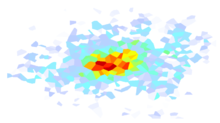shakemap.utils.amps¶
- class shakemap.utils.amps.AmplitudeHandler(install_path, data_path)[source]¶
Bases:
objectStore and associate strong motion peak amplitudes with earthquake events.
Instantiate amplitude handler with ShakeMap profile paths.
- insertEvent(event, update=False)[source]¶
Insert an event into the database.
A directory with name of event[‘id’] should exist in data_path.
- Parameters:
event (dict) –
Dictionary containing fields: - id: Event ID (i.e., us2008abcd). - netid: Network code (i.e., us). - network: Network name (i.e., “USGS Network”). - time: Origin time in UTC (datetime). - lat: Origin latitude (dd). - lon: Origin longitude (dd). - depth: Origin depth (km). - mag: Earthquake magnitude. - locstring: Location string (i.e. ‘2 mi SE of Reno’) - repeats: A list of repeat times (optional) - lastrun: Timestamp of the last run of the event.
(optional)
update (bool) – Update an existing event with new info (True) or insert a new event (False)
- Returns:
Nothing.
- Return type:
nothing
- getEvent(eventid)[source]¶
Return the event parameters for the specified event.
- Parameters:
eventid (str) – The id of the event to query
- Returns:
A dictionary of the columns of the table and their values for the the event; a None is returned if the event is not in the database.
- Return type:
dictionary
- deleteEvent(eventid)[source]¶
Delete the event from the database.
- Parameters:
eventid (str) – The id of the event to delete
- Returns:
Nothing.
- Return type:
nothing
- getRepeats()[source]¶
Return all the rows from the event table where the ‘repeats’ column is not NULL.
- Parameters:
none –
- Returns:
List of tuples of (eventid, origin_time, [repeats]).
- Return type:
(list)
- associateAll(pretty_print=False)[source]¶
Associate peak ground motions with appropriate events, write station XML to file system.
Ground motion records associated with events will be deleted from the database.
- associateOne(eventid, pretty_print=False)[source]¶
Associate peak ground motions with the specified event, write station XML to file system.
Ground motion records associated with events will be deleted from the database.
- Parameters:
- Returns:
The number of amps associated with the specified event. -1 is returned if the event is not found in the database.
- Return type:
- associate(eqtime, eqlat, eqlon)[source]¶
Find peak ground motion records associated with input event info.
Ground motion records associated with input event are deleted from the database. Note that in the case of duplicate stations, the amps from only one will be used, any others will be deleted from the database.
- Parameters:
- Returns:
A list of amps associated with the event. Each row in the list has the following columns:
code: Station code
channel: Channel (HHE, HHN, etc.)
imt: Intensity measure type (pga, pgv, etc.)
value: IMT value.
lat: Station latitude.
lon: Station longitude.
netid: Station contributing network.
name: String describing station name.
distance: Distance (km) from station to origin.
flag: Value will be 0.
loccode: The location code of the instrument.
- Return type:
- writeXML(data_list, eventid, pretty_print=False)[source]¶
Write the list of tuples as an XML file in the event’s current directory.
- Parameters:
data_list (list) –
A list of tuples with the following elements:
station code
channel
imt
imt value
station latitude
station longitude
station’s network id
station’s name string
distance from station to origin
imt flag
channel’s location code
eventid (str) – The event ID of the event associated with the data.
pretty_print (bool) – Whether or not to write the XML in a more human-readable form. If True, the file will be somewhat larger and writing will be somewhat slower.
- Returns:
Nothing.
- Return type:
nothing
- insertAmps(xmlfile)[source]¶
Insert data from amps file into database.
- Parameters:
xmlfile (str) – XML file containing peak ground motion data.
- cleanAmps(threshold=30)[source]¶
Clean out amplitude data that is older than the threshold number of days.
- cleanEvents(threshold=365)[source]¶
Clean out event data that is older than the threshold number of days.
- getStats()[source]¶
Get summary statistics about the database.
- Returns:
Fields:
events Number of events in database.
stations Number of stations in database.
channels Number of unique channels in database.
pgms Number of unique pgms in database.
event_min: Datetime of earliest event in database.
event_max: Datetime of most recent event in database.
- station_min: Datetime of earliest amplitude data in
database.
- station_max: Datetime of most recent amplitude data
in database.
- Return type:
